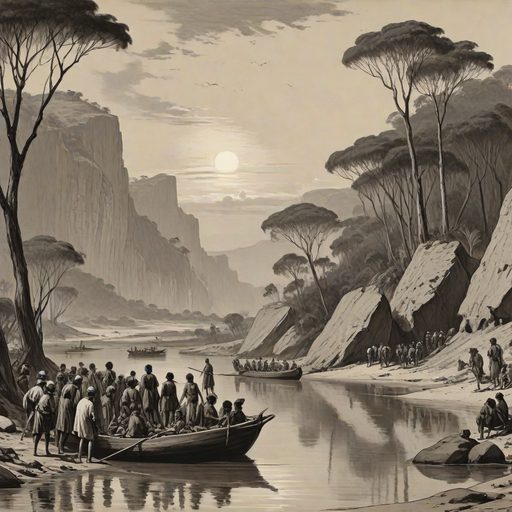
Island of Timor Holds Key to Ancient Human Migration
Recommended for Ancient Migrations & Discoveries
The Unexpected Arrival Signature in Laili Cave
A Geological Time Capsule
Imagine venturing deep into the Laili rock shelter, a cave on the island of Timor. As archaeologists meticulously brush away layers of sediment, they uncover a hidden treasure trove – tens of thousands of artifacts.
Shells, bones, tools, a grindstone, and an intriguing layer of sterile sediment below, untouched by human hands. This sterile layer, like a bookmark in a history book, marks a clear distinction between the time before and after human presence.
Through radiocarbon dating, these artifacts reveal a surprising truth: humans didn’t inhabit Timor until approximately 44,000 years ago. This challenges the long-held belief that Timor was a stepping stone in the ancient migration route from Southeast Asia to Australia. As evidence of humans in Australia dates back even further, to around 65,000 years ago.
A New Chapter in the Human Migration Story
This discovery is a game-changer, forcing archaeologists to reconsider the original migration route. It’s like finding a missing puzzle piece that reshapes our understanding of the past.
The absence of human traces in the older sediment layers suggests that Timor was not a stopover for early humans venturing towards Sahul, the ancient landmass that included Australia, Tasmania, and New Guinea.
Revisiting the Routes of Ancient Mariners
Traditionally, archaeologists considered two primary routes for early humans migrating to Sahul: one through Timor and another through the northern island of Sulawesi. But the Laili cave discovery casts a shadow of doubt on the Timor route, leaving the Sulawesi path as a more likely candidate.
The Sulawesi route gains credibility from the discovery of a 45,500-year-old cave painting of a warty pig, potentially the oldest known rock art on Earth.
This artwork suggests that Sulawesi was indeed inhabited by humans during the crucial migration period.
The Island-Hopping Hypothesis
With Timor seemingly out of the picture, researchers are revisiting the theory of island hopping as the most plausible way early humans reached Sahul. This hypothesis suggests that ancient mariners navigated a series of islands, utilizing their seafaring skills to traverse the vast ocean.
Timor’s Maritime Legacy
While not a migration stepping stone, Timor’s archaeological treasures offer a glimpse into the lives of its early inhabitants. Abundant seafood remains, including shells and fish bones, indicate a thriving maritime economy. Burn marks on these remains suggest that these ancient people harnessed fire for cooking and survival.
The evidence from Timor paints a vivid picture of a coastal community that relied on the sea for sustenance and utilized innovative technologies to navigate its waters. This finding not only sheds light on the island’s history but also contributes to a broader understanding of early human adaptability and resourcefulness.
A Legacy of Exploration and Ingenuity
Timor’s story, though not directly tied to the initial migration to Australia, is a testament to human resilience and ingenuity. It showcases the ability of early communities to adapt to their environment, develop complex societies, and leave behind a rich legacy of cultural and technological achievements.
In conclusion, the archaeological discoveries on Timor Island have reshaped our understanding of early human migration and shed light on the island’s unique maritime heritage.
While Timor may not have been a direct stepping stone to Sahul, its story is a captivating chapter in the ongoing saga of human exploration and adaptation.
Watch a video
Meet Your Ancient Relatives: Neanderthals (TED Talk)!
Curious Times is a leading newspaper and website for kids. We publish daily global news aligned to your learning levels (also as per NEP 2020): Foundational, Preparatory (Primary), Middle and Senior. So, check out the News tab for this. We bring kids’ favourite Curious Times Weekly newspaper every weekend with top news, feature stories and kids’ contributions. Also, check out daily JokesPoke, Tongue Twisters, Word of the Day and Quote of the Day, kids need it all the time.
Curious Times News Program for Schools for FREE. Over 5,000 schools and teachers from all over the world have joined our programme so that students and teachers can get FREE Educative Newspaper. Here, kids can take part in world events and win prizes and certificates for free through their schools.
Moreover, schools are sharing important School News, like interviews with the principal, notices about new students, contests, and results, not just on social media but also on a news website for kids and other schools.
Thus, do not wait any further, sign-up for your school for FREE.
The following social media platforms allow you to communicate with us: WhatsApp, Instagram, Facebook, Youtube, Twitter, and LinkedIn.
0 (Please login to give a Curious Clap to your friend.)
